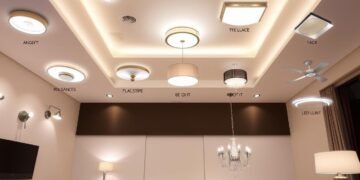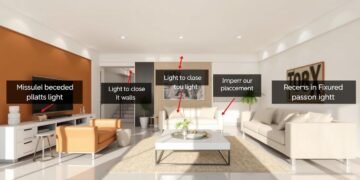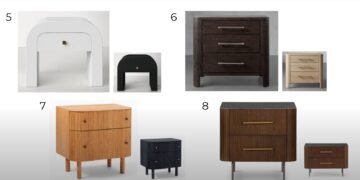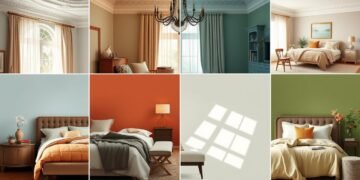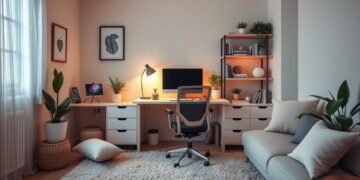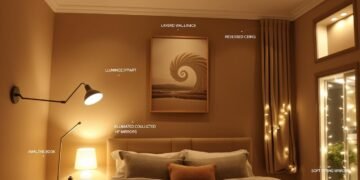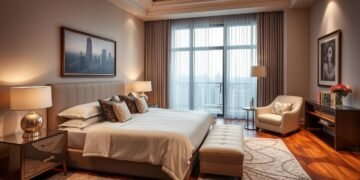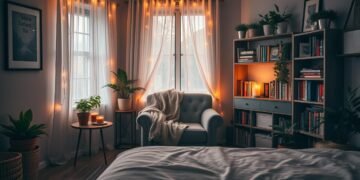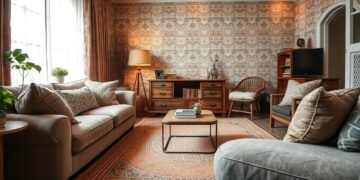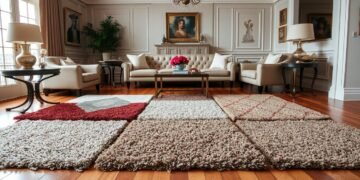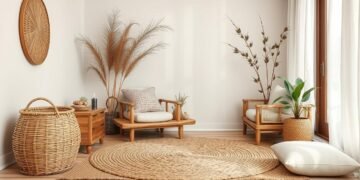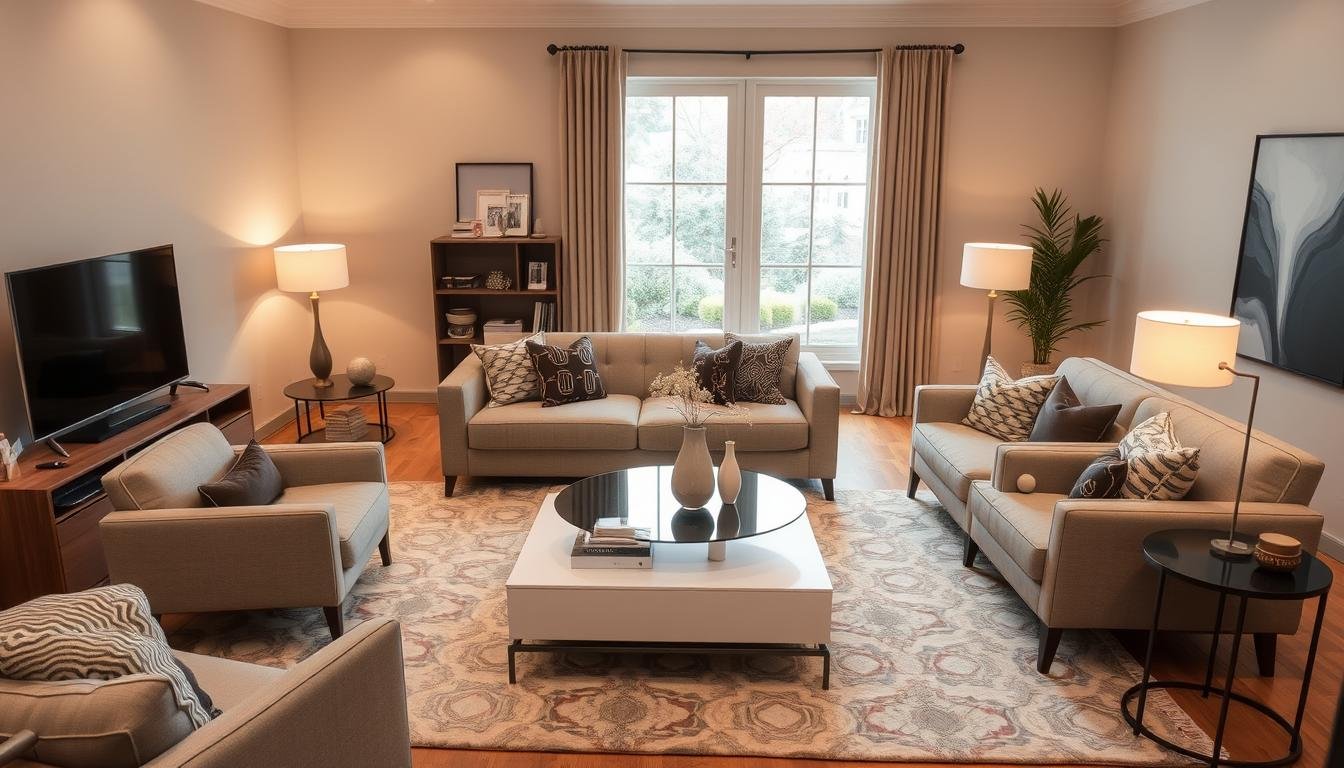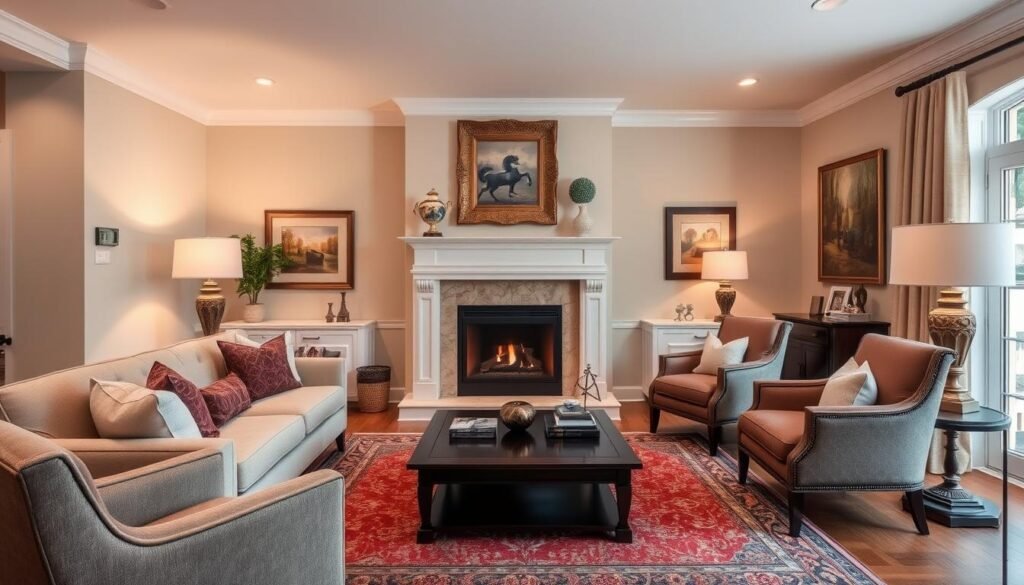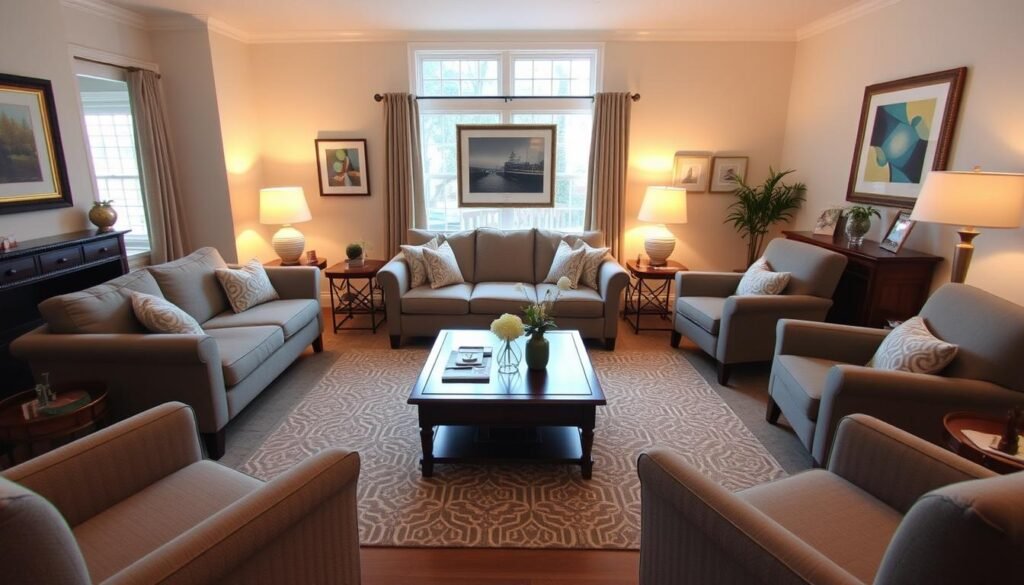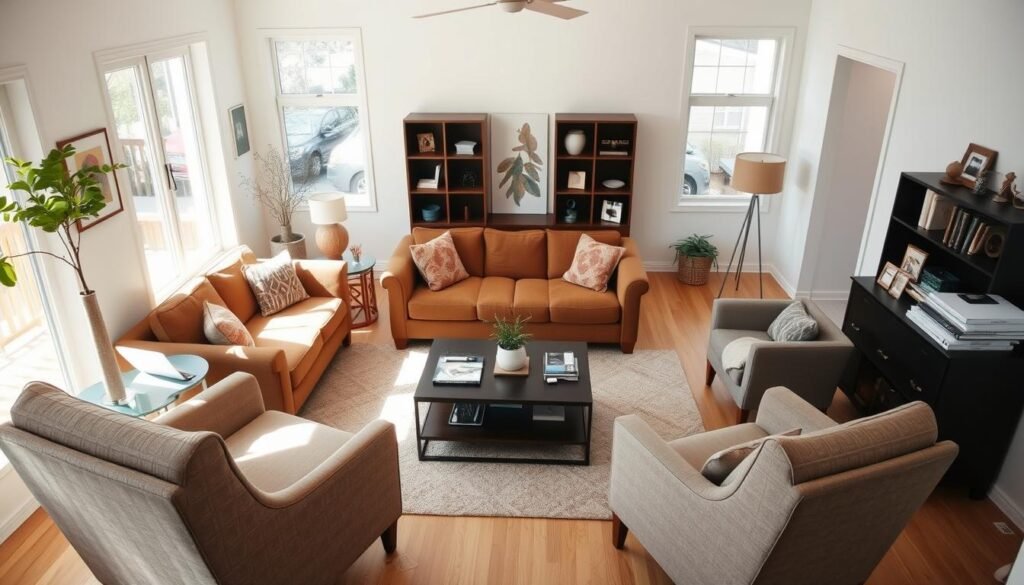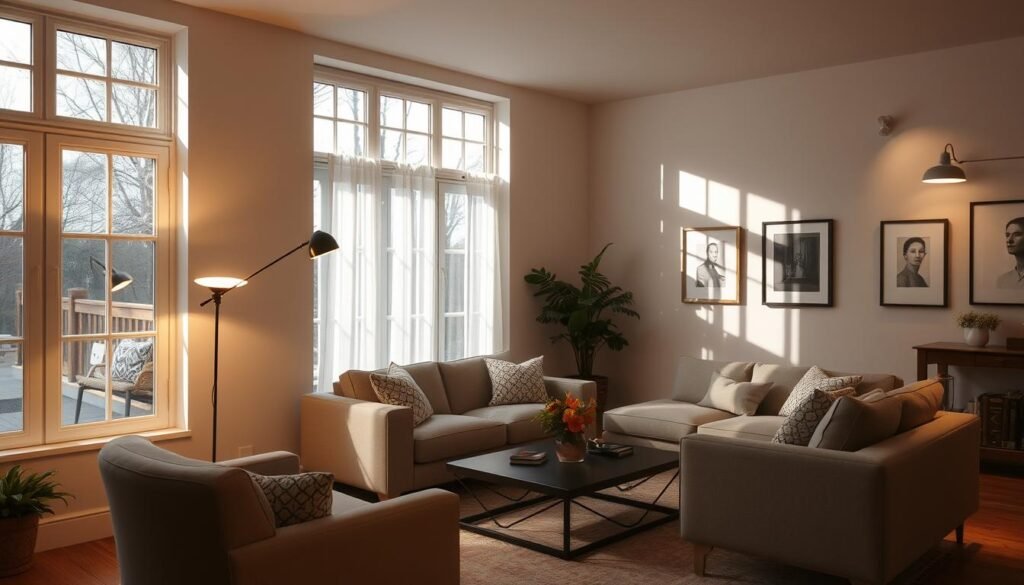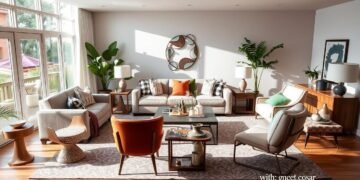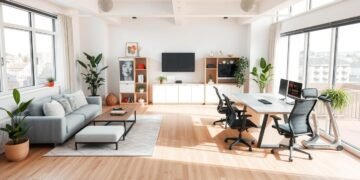When you enter your living room, the furniture layout is key. It can either enhance or detract from the room’s feel. Whether you’re moving or just updating your space, getting the furniture right is essential. Many people make common mistakes that make their rooms feel off and unwelcoming.
In this article, we’ll explore the seven most common furniture arrangement errors. We’ll also share expert tips to help you avoid them. By understanding how to place furniture correctly, you can turn your living room into a beautiful and functional space that suits your lifestyle.
Table of Contents
- 1 Understanding the Importance of Proper Furniture Layout
- 1.1 Impact on Room Functionality
- 1.2 Effect on Visual Appeal
- 1.3 Relatedarticles
- 1.4 8 Tips for Balancing Symmetry and Asymmetry in Your Furniture Layouts
- 1.5 5 Effective Layout Strategies for Multi-Purpose Rooms & Shared Spaces
- 1.6 6 Virtual Tools & Apps to Perfect Your Layout Before You Buy
- 1.7 Influence on Traffic Flow
- 2 Ignoring the Room’s Focal Point
- 3 Common Furniture Arrangement Mistakes That Affect Room Flow
- 4 The Science of Proper Furniture Scaling
- 5 Essential Space Planning Principles
- 6 Lighting Considerations in Furniture Placement
- 7 Creating Balance Through Strategic Placement
- 8 The Role of Accent Furniture and Accessories
- 9 Multi-functional Space Planning Solutions
- 10 Wall Placement and Window Considerations
- 11 Expert Tips for Small Space Furniture Arrangement
- 12 Conclusion
- 13 FAQ
- 13.1 What is the impact of proper furniture arrangement on room functionality?
- 13.2 How does furniture placement impact the overall ambiance and feel of a room?
- 13.3 Why is identifying and working with the room’s focal point important for creating a cohesive layout?
- 13.4 What are some of the common mistakes that disrupt room flow?
- 13.5 Why is proper furniture scaling important for a well-designed room?
- 13.6 What are some key space planning principles to consider when arranging furniture?
- 13.7 How does lighting play a role in furniture placement and overall room ambiance?
- 13.8 How can you achieve balance through strategic furniture placement?
- 13.9 What is the role of accent furniture and accessories in completing a room’s design?
- 13.10 How can furniture arrangement be optimized in multi-functional spaces and open-plan living?
- 13.11 What should be considered when arranging furniture near walls and windows?
- 13.12 How can furniture arrangement be optimized in small spaces?
Key Takeaways
- Ignoring the room’s focal point can lead to a misaligned and disjointed layout1
- Measuring furniture before purchasing ensures it fits the scale of the room1
- Considering flow and circulation is key for a functional and comfy layout1
- Incorporating layered lighting adds ambiance and improves the design1
- Pay attention to details with accessories and decor to make the space personal and warm1
Understanding the Importance of Proper Furniture Layout
The way we arrange furniture in a room greatly affects its look and feel2. It’s key to making a space that looks good and works well for daily life.
Impact on Room Functionality
How we place furniture in a room can really change how we use it3. Smart furniture placement helps us move around easily and makes sure everyone has a comfy spot. But, bad layouts can mess up the room’s flow and use.
Effect on Visual Appeal
Where we put furniture is very important for a room’s look2. If furniture is too close to walls or there are too many focal points, a room can feel small and messy. But, a well-thought-out layout can make a room look better and feel welcoming.
Influence on Traffic Flow
The position of furniture can really affect how we move around in a room2. Good furniture placement helps us move smoothly, with sofas and other pieces guiding us. Bad placement can make a room feel crowded and hard to navigate.
Understanding the role of furniture layout is essential for creating spaces that are both beautiful and useful3. It’s important to think about the room’s purpose, how people will move through it, and the size of the furniture. This way, we can design spaces that are both harmonious and practical for everyday use.
Ignoring the Room’s Focal Point
One big mistake in furniture arrangement is ignoring the room’s focal point. This could be a stunning fireplace, a beautiful piece of art, or a large window. It’s key to find and use this central feature to make the room look good4. Place your furniture to make this focal point stand out, guiding the eye and creating a balanced design4.
Don’t let the TV be the main attraction, as it can mess up the room’s look4. Think of smart ways to hide or show the TV, so the room’s real focal point gets the spotlight4.
By focusing on the room’s natural focal point, you add balance and purpose to the space4. This simple trick can greatly improve your room’s look and feel4.
“A room’s focal point is the first thing the eye is drawn to, and it should be the anchor of the overall design.”
Common Furniture Arrangement Mistakes That Affect Room Flow
Creating a smooth room flow is key to a great living space. Yet, many people make mistakes with furniture placement. These errors can mess up movement and harm the room’s look and use.
Blocking Natural Pathways
One big mistake is blocking room paths with furniture. Placing furniture without thought can make a room feel small and messy. Designer Kati Curtis says ignoring the room’s purpose can waste time and money on furniture that looks good but doesn’t work well.5
Poor Space Distribution
Another issue is furniture not spread out evenly. Putting everything against walls or in the middle can make a room feel off-balance. Designer Jennifer Davis suggests not pushing all furniture against walls to avoid a disconnected feel. She recommends creating cozy areas by moving furniture away from walls.5 Kati advises using rugs to tie furniture together and define areas in a room to avoid feeling disjointed.5
Incorrect Distance Between Pieces
It’s important to keep furniture at the right distance for a smooth flow. Furniture too close makes a room feel tight, while too far apart makes it feel odd. Designer Victoria Holly stresses the need for enough seating and different types to encourage talking and socializing.5 Designer Kathy Kuo warns against too much furniture, which can make a room feel small. She suggests using space wisely to ensure room to move.5
Avoiding these common mistakes can make your living area better for moving around, look nicer, and work better.
The Science of Proper Furniture Scaling
Getting the right furniture sizing and proportions is key for a cozy and useful living area. Knowing how to scale furniture to fit your room size and interior design is essential6.
One basic rule is to leave enough space to walk between big furniture pieces. Designers say 30″ to 36″ is best between sofas and chairs to prevent clutter. If space is tight, 18″ to 24″ is okay6. Also, seats should be 3.5′ to 10′ apart for comfort and flow6.
Choosing the right spot for your furniture is also important. Sofas should be 3-5″ from the wall for room to breathe. Coffee tables should match the sofa’s length for balance6. The sofa and coffee table should be 16″ to 18″ apart for easy reach and style6.
Area rugs should fit the sofa and chairs’ front legs, usually an 8×10 or bigger6. The rug’s spot in the room should leave 24″ of empty space around it in big rooms and 10″ to 18″ in small ones6.
Lighting is also key in furniture proportions. Floor lamps should be 68″ tall, and wall sconces 5′ to 6′ from the floor for good light6. Ceiling lights should match the room’s size, with a width 2.5 to 3 times the ceiling height or the room’s length and width in inches6.
By following these furniture sizing, proportions, and room size tips, you can make a beautiful and useful living space. It will blend all parts of your interior design smoothly7.
Essential Space Planning Principles
Good space planning is key to a well-designed home. It involves thinking about traffic flow, room zones, and furniture placement. This way, you can make spaces that are both useful and look good8.
Traffic Flow Considerations
Make sure there are clear paths in your room. You should have at least 3 feet of space in busy areas for easy movement9. Place furniture to create zones and guide the eye. Use the rule of thirds for a balanced look9.
Room Zoning Techniques
Split your space into areas for different activities. This could be for sitting, dining, or working. Zoning makes your space more functional and interesting, even in open-plan areas9. Use furniture, rugs, and lights to mark these zones well.
Furniture Spacing Guidelines
It’s important to space out furniture right. Sofas should be about 12 inches from windows, and seating should encourage talking8. In big rooms, set up different seating spots or use floating furniture to use space better8.
By following these space planning tips, you can make your living areas welcoming, useful, and beautiful. These spaces will fit your lifestyle perfectly8910.
Lighting Considerations in Furniture Placement
Good lighting is key to a nice-looking and useful furniture setup. Don’t just use overhead lights, as they can make shadows and uneven light. Use a mix of ambient, task, and accent lights11.
Use floor lamps, table lamps, and wall sconces to make your space cozy. You can change the light to match your mood or what you’re doing. Adding dimmer switches gives you more control over the light11.
Place your furniture near windows and skylights for natural light. This cuts down on the need for artificial light and makes your space lively12.
Lighting should be balanced. Too many lights can make a room feel busy. Mix ambient, task, and accent lights to make your space look good and work well12.
By using these lighting tips, you can make your space more welcoming, comfy, and pretty1112.
Lighting does more than just light up a room. It sets the mood, adds ambiance, and changes how a room looks. By thinking about lighting when you arrange your furniture, you can make your living area the best it can be1112.
“Lighting has the power to transform a room, and it’s a key part of any good furniture setup.”
| Lighting Type | Purpose | Recommended Placement |
|---|---|---|
| Ambient Lighting | Provides overall illumination and sets the mood | Overhead fixtures, wall sconces, floor lamps |
| Task Lighting | Focused lighting for specific activities | Table lamps, under-cabinet lighting, reading lamps |
| Accent Lighting | Highlights architectural features or artwork | Recessed lighting, track lighting, picture lights |
By thinking about lighting when you arrange your furniture, you can make a space that looks good and meets your needs1112.
Creating Balance Through Strategic Placement
Getting your furniture to look balanced is key to a nice room. You can use both symmetrical and asymmetrical designs to achieve this13.
Symmetrical vs Asymmetrical Arrangements
Symmetrical designs are classic and formal13. Asymmetrical designs, on the other hand, are modern and casual13. Knowing how each style affects your space is important.
Visual Weight Distribution
Think about the size and weight of your furniture when arranging it13. Balance big, heavy pieces with smaller, lighter ones for balance13. Consider the size and shape of each piece to make sure they fit well together13. Use color, texture, and decor to make your space more interesting.
Mastering symmetrical and asymmetrical designs, along with balancing visual weight, can make your room beautiful and functional1314.
| Metric | Recommendation |
|---|---|
| Optimal number of furniture pieces | Experts say keep furniture to 8-10 pieces for a clean look14. |
| Furniture spacing | Leave 3-4 feet around each piece for easy movement and a clean feel14. |
| Seating arrangement in media rooms | For the best TV viewing, match seating size to TV size14. |
| Floating furniture placement | Place furniture in the room’s center for a cozy area in big rooms14. |
| Variation in furniture styles | Mix different furniture styles and sizes for a balanced look14. |
| Cohesive color scheme | Use the same color throughout for a harmonious look14. |
By using these strategies, you can make your living space beautiful and functional. It will show off your personal style14.
The Role of Accent Furniture and Accessories
Make your living space better by adding accent furniture and decorative accessories. These items bring personality, depth, and interest to any room. Layering in design with the right pieces shows off your style and finishes the look15.
First, find the main spots in your room, like a fireplace or entertainment center. Use accent chairs, side tables, rugs, and throw pillows to make these areas cozy1617. Add vases, candles, and artwork to give your space character and texture15.
Choose accent furniture and accessories that match your room’s colors, textures, and style. Look for pieces that enhance your space and fit your desired look, whether it’s modern, traditional, or something in between15.
Use different sizes, shapes, and materials to add depth and interest. A big area rug, throw pillows, and a blanket can change a living room fast1516.
By carefully picking accent furniture and accessories, you can improve your living space’s design. You’ll also show off your unique style1517.
Multi-functional Space Planning Solutions
In today’s homes, multi-functional spaces and open-plan living are more popular than ever. To make open spaces feel like different areas, smart furniture placement and rug use are key18. Choosing flexible, movable furniture pieces lets homeowners change their space as needed18.
Open Plan Living Considerations
In an open-plan layout, figuring out how to divide the space is critical. Using room dividers or bookcases can help set up different areas without blocking the openness19. Placing furniture in groups, not just against walls, improves the room’s flow and use19.
Flexible Furniture Arrangements
With flexible furniture arrangements, homeowners can change their space for different activities or events18. It’s important to think about the size and shape of furniture to avoid making the room feel too full or cramped19. Using different rugs and patterns can also help mark off areas in an open-plan space, keeping it looking unified19.
“The key to successful multi-functional space planning is finding the right balance between zoning and flexibility. By strategically arranging furniture and incorporating adaptable design elements, homeowners can create spaces that truly cater to their evolving needs.”
Wall Placement and Window Considerations
When setting up furniture, think about where walls and windows are. Don’t just push everything against the walls. This can make your room look unbalanced and dull20.
Make sure furniture near windows doesn’t block light or mess with your curtains. Use furniture to highlight windows and enjoy great views. Remember, natural light changes how colors and furniture look throughout the day20.
- Avoid pushing all furniture against walls, as this can create an unbalanced look21.
- Think about how you use your space. For example, put comfy seats near the TV if you watch a lot21.
- Use unique items like ottomans and sectional sofas to make your space interesting but not cluttered21.
By carefully placing furniture, you can make your room look good and work well. Remember, where you put furniture is key to a nice and useful room20.
Dining Room Furniture Arrangement
In the dining room, there are key things to remember. Make sure there’s at least 36 inches (90 cm) between the table and walls or other furniture22. This lets people move easily and chairs can be pulled out without getting stuck.
| Table Size | Seating Capacity |
|---|---|
| Round table, 48 inches (122 cm) | 4-6 people22 |
| Round table, 60 inches (152 cm) | 6-8 people22 |
| Rectangular table, 72 inches (183 cm) | 6 people22 |
| Rectangular table, 96 inches (244 cm) | 8 people22 |
| Rectangular table, 120 inches (305 cm) | 10 people22 |
| Square table, 36-54 inches (91-137 cm) | 4 people22 |
| Square table, 60 inches (152 cm) | 8 people22 |
Lighting in the dining room should be about 30-34 inches above the table for good light22. Mirrors can make small dining areas look bigger22. In small spaces, round tables and chairs without arms help with flow. Also, using furniture that can do more, like storage benches, makes the most of your space22.
“Thoughtful furniture placement is the key to a functional and aesthetically pleasing room.”
Expert Tips for Small Space Furniture Arrangement
Working with little space means making every inch count. Use smart strategies and visual tricks to make your small space cozy and beautiful23.
Choose furniture that does more than one thing, like ottomans with storage or tables that expand. Pick furniture that fits well in the room to keep it feeling open. Use tall shelves and mirrors to make the room look bigger and brighter24.
Keep paths clear and don’t overfill the room with too much furniture. Designer Stephanie Abernathy says to leave at least 36 inches for moving around23. Furniture with open legs makes rooms feel more airy. Mixing up the heights of your furniture adds interest23.
Don’t block windows with furniture to keep the room light. Also, don’t push all furniture against walls. This can make rooms feel too tight. Instead, leave some space for a balanced look23.
By following these tips, you can make your small space both functional and beautiful. Use furniture that does more, place things wisely, and use tricks to make it look bigger and more welcoming.
| Design Principle | Tip |
|---|---|
| Measure Your Space | Accurately measure the room’s dimensions, including length, width, and height24. |
| Avoid Blocking Windows | Ensure furniture placement doesn’t obstruct natural light flow24. |
| Consider Traffic Flow | Maintain comfortable movement in the room without obstacles24. |
| Mix Different Sizes | Incorporate a balance of large, medium, and small furniture pieces24. |
| Use Rugs to Define Areas | Utilize rugs to delineate specific spaces in open plan layouts24. |
“Proper furniture arrangement is essential for maximizing functionality and creating a visually appealing space, even in small areas. By considering these expert tips, you can transform your compact home into a comfortable, efficient, and stylish haven.”
–Interior Designer Mary Beth Wagner
Conclusion
Getting your furniture right is key to a great living space. By avoiding common mistakes and using room layout tips, you can make your home inviting. It will show off your style and meet your needs.
Think about the room’s main feature and the size of your furniture. Each choice is important for a good look and function. Aim for balance between looks and use, and try out different setups until you’re happy.
Good furniture arrangement is more than looks. It affects how you move around, the light, and the feel of the room. By following these tips, you can make spaces that look good and work well for you. With attention to detail and a bit of creativity, your home will truly reflect you.




